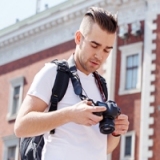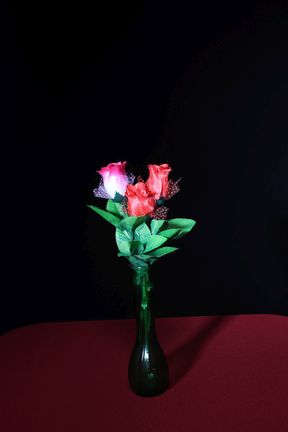- Forum
- General Discussion | Introductions | Off Topic Forum
- Photography General Discussion
- What are you doing during cold wet winter months?
What are you doing during cold wet winter months?
-
 Topic Author
Topic Author
- Stacy Merrow
- Has the Hang of it
-
- Nikon D300
- Followers: 51
- Posts: 87
-
Points:
936
Post #762211
-

- CharleyL
- Photography Hooked
-
- Canon 90D, (2) Canon 77D, Fuji HS20 EXR, Still have my Sony MVC-FD95
- Followers: 72
- Posts: 912
-
Points:
34978
Post #762215
You don't need a studio, but I have one so that's where I do it, but years ago I pushed the furniture around in my living room and made temporary space. It could be any space in your house or even the garage if it's a large enough open space, but you need some place where you can make it completely dark so your photo lights will be the only influence on the photos, a 10 ft diameter open area would be ideal, but you can do with less. I set my camera for the flash sync speed when using flash, and I use my remote on-camera flash control, so I can have full control of my lights from the camera position. For "still life" shoots it's best to not have the light's on the camera, but at different angles around the object that you are photographing. I always turn on one room light somewhere in the room so I can see what I am doing, and then do a "Test shot" or two without any flash, while adjusting the F-Stop of my camera upward until I get a completely black photo, or nearly so. If you do this, you will be able to see what you are doing well, but this room light will not affect your shots and only your flash will cause the lighted areas in your following shots. Now, you are in full control of the light in your shots, as long as you leave the camera on this F-Stop setting. The amount of light and it's direction, etc. will then only be what comes from your flash.
Find a small table or something to place your chosen object that you will be shooting on. A table cloth or even a cloth napkin of your color choice for improving/hiding the table surface of the table helps. Pick something interesting to shoot, ie. a bottle of wine, a vase and flowers (even plastic flowers, if they are real looking). Set up your lighting and then try things. Work your lighting to get the best shots, changing positions and power levels to see what happens. Experiment, work the light and the shadows, taking a few shots after every change from slightly different positions. Try adding something else to the table, or changing one object for another. A simple place setting, or a glass and pitcher of colored liquid, etc. are all good choices.
You will be learning how your lights work, how wide they light, how soft/hard the light from them is, how near/far your lights need to be for this kind of shot. What you can do to control where the light falls on your subject, how hard or soft the light is. Start with just one light, then add a second, but use only the second light until you know the result that you get from it. Then try the same with both lights and you will see how more than one light source can affect the shots. Experiment with the light using diffusing materials and reflectors. Learning your lighting this way will make you a much better photographer while giving you something valuable to do on those dull days.
Attached is a photo that I took back before Christmas 2023. It was an experiment to see how small a diameter that I could get the light from a studio strobe. This strobe happened to be a 400 watt/second, but turned way down. A Snoot (funnel shape) attached to the light with the light about 5' from the roses didn't control the diameter of the light very well at all. So I removed the snoot and installed a standard 7" round reflector, but added a 7" 40 degree grid (basically a honeycomb) to allow only the light rays coming straight out of strobe and up to 40 degrees from straight. It wasn't near enough control, so I changed the grid to 10 degrees and got the result in the attached photo. I have used grids many times over my many years of photography, but had never used the 10 degree before. The resulting light hitting the roses from 5' away was about 8" in diameter and exactly what I was looking for. I reduced the strobe power level a one stop, until the table and vase were almost invisible.
So the roses are all that are seen when first looking at the attached photo, yet the vase and table can be seen, but just barely. If this was for a customer I would remove the bright spot on the vase in post, or would have used a blocking method to prevent the bright spot, but this was just the beginning of my experiment that day and I did not need to please a customer with it.
Charley
-

- Mike McKinnon
- Lone Wolf
-
- Canon 5D Mark III and EOS R
- Followers: 64
- Posts: 146
-
Points:
3007
Post #762226
-

- Harper Coswell
- Has the Hang of it
-
- Canon 60D
- Followers: 46
- Posts: 91
-
Points:
894
Post #762344
-

- Photo Junky
- Snapobsessed
-
- Nikon D750
- Followers: 131
- Posts: 500
-
Points:
5332
Post #762389
-

- Thomas S
- Snapobsessed
-
- Nikon D850
- Followers: 104
- Posts: 270
-
Points:
3179
- Forum
- General Discussion | Introductions | Off Topic Forum
- Photography General Discussion
- What are you doing during cold wet winter months?
Latest Reviews
The Canon EOS R100 is an entry-level mirrorless camera introduced in 2023. But just because it’s an entry-level camera doesn’t mean it’s a bare-bones camera. Find out why in this review!
Nikon’s retro-looking Nikon Zfc is anything but retro. Under its classic body is a host of features and amenities that make it a worthwhile compact mirrorless camera for 2024.
The Canon EOS R50 is one of the newest R-system cameras from Canon. Is it worth your money? Find out all the details you need to know in this comprehensive review.
The Sony FE 70-200mm f/2.8 GM OSS II is Sony’s flagship mirrorless zoom lens. As such, it’s loaded with features and has a top-shelf build quality that makes it a top pick!
Forum Top Posters
-
1TCav 6 posts
-
2Scotty 6 posts
-
3No Show 3 posts
-
4Tristan R 3 posts
-
5Otto F 2 posts
-
6Jackson Rieger 2 posts
-
7Pork Express 2 posts
-
8CharleyL 2 posts
-
9SJM 2 posts
-
10Fitch 2 posts
Latest Articles
Using leading lines in photography helps improve the composition by drawing viewers in and leading their eye from the foreground to the background. Explore some fine examples of this in this guide!
The Insta360 has one of the best lineups of action cams and 360-degree cameras. With these Insta360 accessories, you can elevate your photography and videography game!
Creating impactful photos of landscapes depends on many factors, not the least of which is your talent behind the lens. This guide explores other elements required for the best product.
The Canon EOS R100 is an entry-level mirrorless camera introduced in 2023. But just because it’s an entry-level camera doesn’t mean it’s a bare-bones camera. Find out why in this review!
Are you ready to upgrade your camera? Before buying new, you might consider the value of purchasing used gear to save money.
The Olympus OM-D E-M10 Mark IV is a micro four thirds camera released in 2020. It’s an entry-level system along with the OM-D E-M5 Mark III. Use this guide to determine which one is best for you!
Blue hour photography might not be as well known as golden hour photography, but it is every bit as good a time to create epic images of landscapes. Learn how in this quick tutorial!
Nikon’s retro-looking Nikon Zfc is anything but retro. Under its classic body is a host of features and amenities that make it a worthwhile compact mirrorless camera for 2024.
















